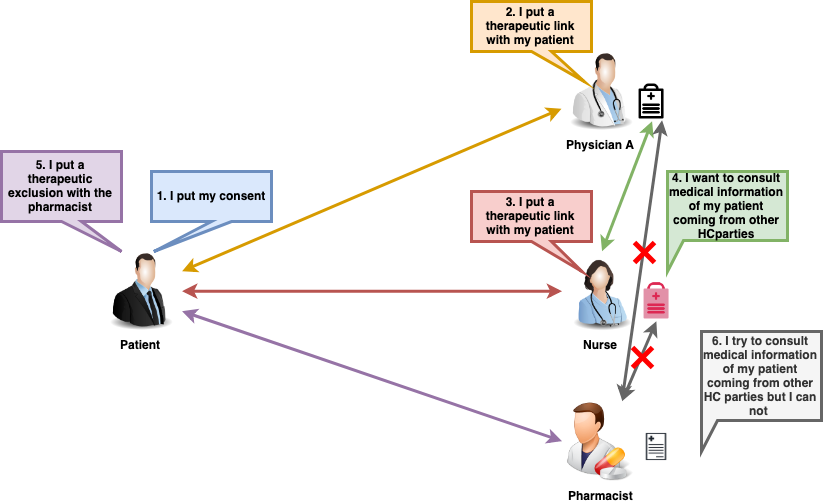Used documentation
| Cookbook/ materials | Version | Location |
|---|---|---|
| Therapeutic Link Web Service | 1.5 | |
| Identity & Authorization Management (I.AM) Token eXchange Technical specifications | 1.0 | https://www.ehealth.fgov.be/ehealthplatform/nl/data/file/view/83dd54fee269ec086696b0290d242907c6e9f994?name=IAM%20Connect%20Token%20eXchange%20-%20Tech%20Specs%20v1%20-%2004072018.pdf |
| KMEHR | - | https://www.ehealth.fgov.be/standards/kmehr/en |
| Jira ticket MHEH-12 | - | MHEH-12 - Getting issue details... STATUS |
| Jira ticket MHEH-13 | - | |
| Jira ticket MHEH-18 | - |
MHEH-18
-
Getting issue details...
STATUS
|
| Jira ticket MHEH-20 | - | MHEH-20 - Getting issue details... STATUS |
| Jira ticket MHEH-26 | - | MHEH-26 - Getting issue details... STATUS |
| Jira ticket MHEH-31 | - | MHEH-31 - Getting issue details... STATUS |
| Jira ticket MHEH-32 | - |
MHEH-32
-
Getting issue details...
STATUS
|
General information
In the figure below, we present a logical view about the relationship between the three basic services of the ehealth platform that are the WS Consent, the Therapeutic link WS, and the Therapeutic exclusion services. A Therapeutic link can be managed by the following end-users:
- Health Care (HC) parties: a physician, nurse, dentist, midwife, a pharmacy (it is noteworthy that there is no difference between pharmacy and a pharmacist), authorized organization.
- Citizen: a patient, a parent of a patient, a mandatary
The Therapeutic Link Web service provides three methods (it is noteworthy that in this use case only the GetTherapeuticLink method is used):
- The "PutTherapeuticLink" method allows an end-user to declare a therapeutic link.
- The "RevokeTherapeuticLink" method enables an end-user to revoke a therapeutic link.
- The "GetTherapeuticLink" method allows an end-user to consult the therapeutic links list of a given patient. Indeed, it enables to check the existence of a given therapeutic link between a patient and a HCP.
Th "GetTherapeuticLink" method allows users to check the existence of therapeutic links between a HC party and a patient. Depending on the input parameters the service can support the following functionalities:
- check the existence of a specific link between a patient and a HC party;
- consult the list of therapeutic links related to a patient;
- consult the list of therapeutic links between given HC party and given patient over a certain time period.
Basic flow
| Flow | Specification | ||
|---|---|---|---|
Use case ID | ATH-UC-12-BF | ||
Use case name | Consult an active consent of a patient | ||
Actors |
| ||
Short Description | In order to consult the consent of a patient using the SOA-based version, it is important to use the Token exchange service in order to convert a JWT message into a SAML one (and vice versa). The aim of this use case is to check a consent status after its activation or revoke. | ||
| Priority | 1 (High) Must have: The system must implement this goal/ assumption to be accepted. | ||
Pre-Conditions |
| ||
Post-Conditions |
| ||
Steps (basic flow) | 1 | The user tries to consult the consent and the client sends a getPatientConsent request to the IAM connect | |
| 2 | The IAM connect routes the request to the WS consent | ||
3 | The WS consent finds information about the consent of a patient | ||
| 4 | The WS consent sends a SAML-based response to the IAM | ||
5 | The IAM connect receives the response and sends it to the client using a JWT format by interacting with the token exchange service | ||
| 6 | The client receives information about the consent of the patient | ||
Exceptions (exception flows) |
| ||
Frequency |
| ||
